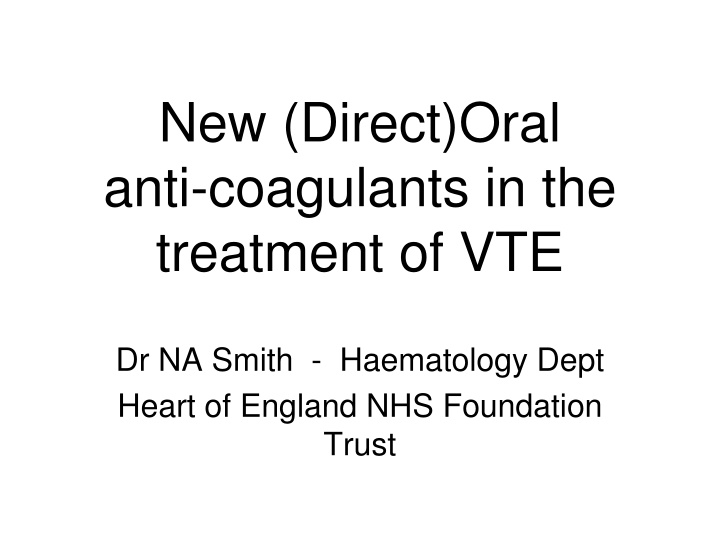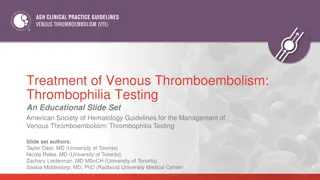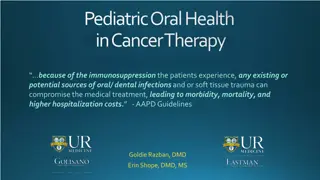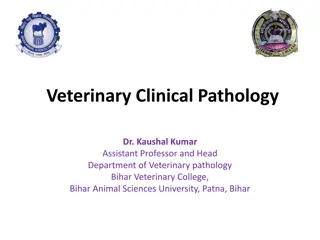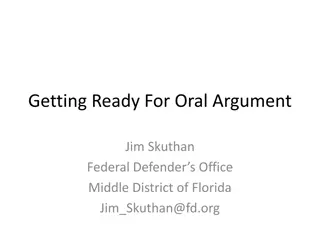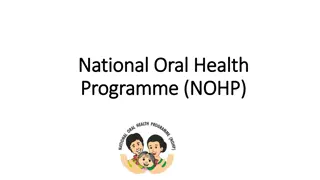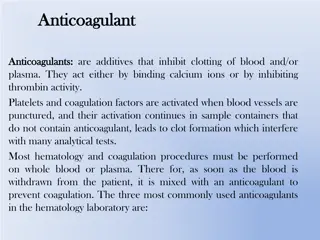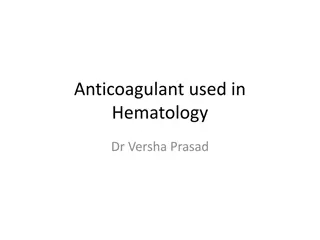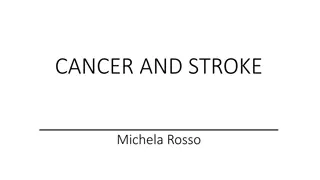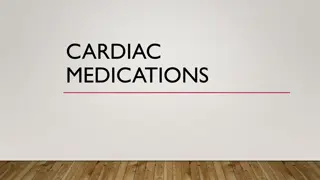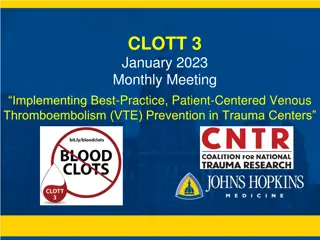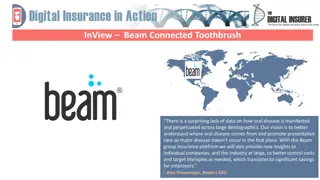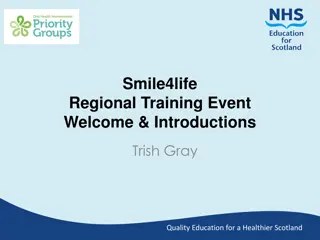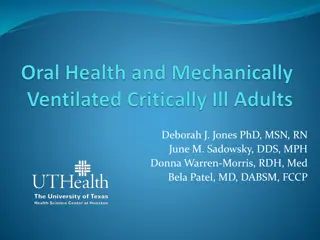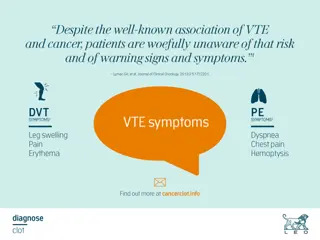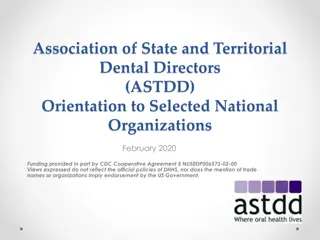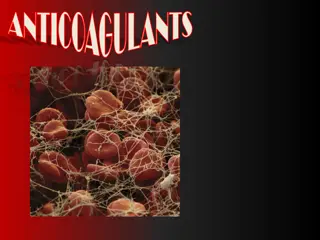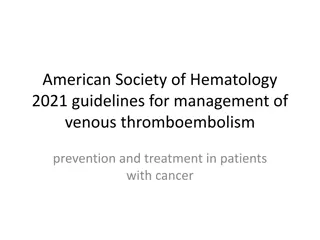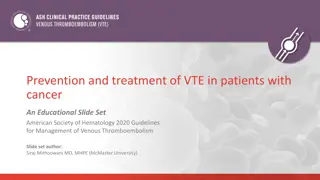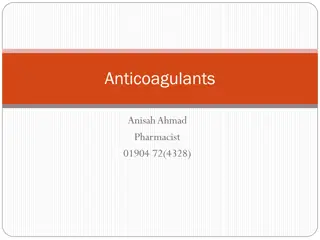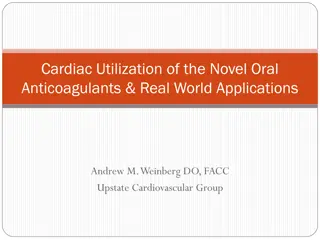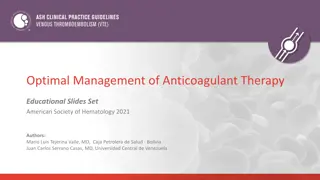New Oral Anticoagulants in VTE Treatment Overview
Venous thromboembolism (VTE) poses serious risks including death and venous ulcers. Explore the use of new direct oral anticoagulants, NOACs, in VTE treatment, comparing them to traditional drugs like Warfarin. Learn about specific NOAC agents, treatment duration, and factors such as DASH score and Hospital-associated thrombosis.
Download Presentation

Please find below an Image/Link to download the presentation.
The content on the website is provided AS IS for your information and personal use only. It may not be sold, licensed, or shared on other websites without obtaining consent from the author.If you encounter any issues during the download, it is possible that the publisher has removed the file from their server.
You are allowed to download the files provided on this website for personal or commercial use, subject to the condition that they are used lawfully. All files are the property of their respective owners.
The content on the website is provided AS IS for your information and personal use only. It may not be sold, licensed, or shared on other websites without obtaining consent from the author.
E N D
Presentation Transcript
New (Direct)Oral anti-coagulants in the treatment of VTE Dr NA Smith - Haematology Dept Heart of England NHS Foundation Trust
Venous thromboembolism (VTE) DVT Deep vein insufficiency PE Post-thrombotic syndrome Pulmonary hypertension Death Venous Ulcers Crude mortality 15-20% within 3 months of diagnosis
Total VTE's HEFT (FY 2014-2015) PE 263 45% DVT 322 55%
NOACs What are they Are they good Are they safe How much are we using How much will we be using
New VTE anticoagulation issues Duration of treatment DASH score Unprovoked vs Provoked Hospital associated thrombosis (HATs)
New Oral Anticoagulants (NOAC) Dabigatran - NICE (SPAF) March 2012 NICE (VTE) Dec 2014 Rivaroxaban - NICE (SPAF) May 2012 NICE (VTE) July 2012 NICE (ACS) March 2015 Apixaban - NICE (SPAF) Feb 2013 NICE (VTE) June 2015 Edoxaban - NICE (SPAF) Aug 2015 (VTE) Aug 2015
Old drugs Warfarin (VKA s) Reduction in production of factors II, VII, IX and X VII VIIa TF IX X Inactive factor IXa Xa Active factor Transformation II Prothrombin AT Catalysis Heparins Indirect inhibition via potentiation of Anti-thrombin III IIa Thrombin Clot formation Fibrinogen Fibrin Adapted from Spyropoulos AC. Expert Opin Investig Drugs 2007;16:431 440
Direct Factor IIa & Xa inhibitors DOACs or NOAC s! VII VIIa TF Inactive factor Active factor IX X Transformation Catalysis Direct Factor Xa inhibition Rivaroxaban Apixaban Edoxaban IXa Xa II Prothrombin Direct Factor IIa inhibition Dabigatran etexilate IIa Thrombin Fibrinogen Fibrin Adapted from Spyropoulos AC. Expert Opin Investig Drugs 2007;16:431 440
New Agents Charecteristic target Prodrug Bioavailability Dosing Time to peak Half-life Renal Clearance Interactions Dabigatran Thrombin (IIa) Yes 6% BD 1-3 hr 8 15 hr 80% P-gp Rivaroxaban F Xa No 60-80% OD 2-4 Hr 7 11 hr 33% 3A4 / P-gp Apixaban FXa No 60% BD 1-2 Hr 12 hr 25% 3A4 / P-gp
EINSTEIN DVT: primary efficacy outcome - Time to first event 4.0 Enoxaparin/VKA (n=1,718) Cumulative event rate (%) 3.0 Rivaroxaban (n=1,731) 2.0 HR=0.68; p<0.001 1.0 0 0 30 60 90 120 150 180 210 240 270 300 330 360 Time to event (days) The EINSTEIN Investigators. N Engl J Med 2010;363:2499 2510
EINSTEIN-DVT: primary efficacy outcome and key safety outcomes EINSTEIN-DVT trial: open-label, randomised trial comparing rivaroxaban treatment (15 mg twice daily for 21d, then 20 mg once daily for 3, 6 or 12 months) with enoxaparin bridging to VKA therapy in patients with acute symptomatic DVT Enoxaparin/VK A (n=1,718) Rivaroxaban (n=1,731) HR P Value (95% CI) Primary efficacy outcome (mean study duration: ~9 months) Recurrent VTE, n (%) 0.68 <0.001 Non-inferiority 36 (2.1) 51 (3.0) (0.44 1.04) Enoxaparin/VK A (n=1,711) Rivaroxaban (n=1,718) HR P Value (95% CI) Safety outcomes Major or CRNM bleeding, n (%) 0.97 139 (8.1) 138 (8.1) 0.77 (0.76 1.22) Major bleeding, n (%) 0.65 14 (0.8) 20 (1.2) 0.21 (0.33 1.30) 0 1 2.0 Favours rivaroxaban Favours enoxaparin/VKA ELQ771b Date of preparation: June 2015 The EINSTEIN Investigators. N Engl J Med. 2010;363:2499 2510.
EINSTEIN-PE: primary efficacy outcome and key safety outcomes EINSTEIN-PE trial: open-label, randomised trial comparing rivaroxaban treatment (15 mg twice daily for 21d, then 20 mg once daily for 3, 6 or 12 months) vs enoxaparin + VKA therapy in pts with acute symptomatic PE with or without symptomatic DVT Enoxaparin/ VKA (n=2,413) Rivaroxaban (n=2,419) HR P Value (95% CI) Primary efficacy outcome (mean study duration: ~9 months) 0.003 Non- inferiority Recurrent VTE, n (%) 1.12 50 (2.1) 44 (1.8) (0.75 1.68) Enoxaparin/ VKA (n=2,405) Rivaroxaban (n=2,412) HR P Value (95% CI) Safety outcomes Major or CRNM bleeding, n (%) 0.90 249 (10.3) 274 (11.4) 0.23 (0.76 1.07) Major bleeding, n (%) 0.49 26 (1.1) 52 (2.2) 0.003 (0.31 0.79) 0 1 2.0 Favours Favours enoxaparin/VKA rivaroxaban ELQ771b Date of preparation: June 2015 The EINSTEIN-PE Investigators. N Engl J Med. 2012;366:1287 1297.
Apixaban in VTE Amplify study Randomised, double-blind active-controlled, non-inferiority study To evaluate the efficacy and safety of apixaban alone with conventional anticoagulant therapy (enoxaparin/warfarin) for 6 months in patients with acute symptomatic DVT and/or PE Enoxaparin (1 mg/kg) BD SC N=2704 30-day safety follow-up Warfarin (INR 2 3) End of treatment acute symptomatic proximal DVT and/ or PE N=5400 (randomised) R Apixaban twice daily N=2691 10 mg BD D1 5 mg BD D7 Time: 6 months Stratification based on DVT and PE; randomisation target was two-thirds DVT and one-third PE ELQ564c Date of preparation: October 2014 Agnelli et al. N Engl J Med 2013; 369:799 808.
AMPLIFY: recurrent VTE or VTE-related death Primary efficacy outcome Enoxaparin/warfarin (events: 71/2,704) 3 Cumulative event rate (%) 2 Apixaban (events: 59/2,691) 1 RR 0.84 (95% CI, 0.60 1.18) P<0.001 (non-inferiority) For warfarin-treated subjects, TTR was 61% 0 0 30 60 90 120 150 180 210 240 270 300 Days to VTE/VTE-related death No. of patients at risk Apixaban Eno/war 2,691 2,606 2,704 2,609 2,585 2,555 2,543 2,533 2,586 2,563 2,541 2,523 62 43 4 3 1 1 0 1 0 0 Eno, enoxaparin; TTR, time in therapeutic range; War, warfarin. ELQ771b Date of preparation: June 2015 Agnelli et al. N Engl J Med. 2013;369:799 808.
AMPLIFY: major bleeding Primary safety outcome Enoxaparin/warfarin (events: 49/2,689) 2 Cumulative event rate (%) ARR 1.2% RR 0.31 (95% CI, 0.17 0.55) P<0.001 (superiority) 1 Apixaban (events: 15/2,676) 0 0 30 60 90 120 150 180 210 240 270 300 Days to major bleeding No. of patients at risk Apixaban Eno/war 2,676 2,519 2,460 2,409 2,373 2,339 2,689 2,488 2,426 2,383 2,339 2,310 43 61 4 3 1 1 0 1 0 0 ELQ771b Date of preparation: June 2015 Agnelli et al. N Engl J Med. 2013;369:799 808.
AMPLIFY: major bleeding vs enoxaparin/warfarin Major or CRNM bleeding* RR (95% CI) 0.44 (0.36 0.55) P<0.001 56% RRR Major bleeding* RR (95% CI) 0.31 (0.17 0.55) P<0.001 for superiority 69% RRR 12 9.7% 10 Patients with event (%) 261/ 2,704 8 6 4.3% 4 115/ 2,691 1.8% 2 0.6% 15/2,676 49/2,689 0 Apixaban Enoxaparin/ warfarin Apixaban Enoxaparin/ warfarin CRNM, clinically relevant non-major; RRR, relative risk reduction. * For patients who had >1 event, only the first event was counted. ELQ771b Date of preparation: June 2015 Agnelli et al. N Engl J Med. 2013;369:799 808.
AMPLIFY: primary efficacy outcome and key safety outcomes AMPLIFY trial was a double-blind, randomised trial comparing 6 months of apixaban treatment with enoxaparin bridging to warfarin therapy in patients with acute symptomatic DVT and/or PE Enoxaparin/ warfarin (n=2,635) Apixaban (n=2,609) RR P Value (95% CI) Primary efficacy outcome Recurrent VTE or VTE-related death, n (%) <0.001 Non- inferiority 0.84 59 (2.3) 71 (2.7) (0.60 1.18) Enoxaparin/ warfarin (n=2,689) Apixaban (n=2,676) RR P Value (95% CI) Safety outcomes Major bleeding, n (%) 0.31 15 (0.6) 49 (1.8) <0.001 (0.17 0.55) Major or CRNM bleeding, n (%) 0.44 115 (4.3) 261 (9.7) <0.001 (0.36 0.55) 0 1 2.0 Favours Favours apixaban enoxaparin/warfarin HR, hazard ratio. ELQ771b Date of preparation: June 2015 Agnelli et al. N Engl J Med. 2013;369:799 808.
RE-COVER: primary efficacy outcome and key safety outcomes RE-COVER trial was a double-blind, double-dummy, randomised trial comparing 6 months of dabigatran treatment (150 mg twice daily) with heparin* bridging to dose- adjusted warfarin therapy in patients with acute symptomatic DVT and/or PE Heparin*/ warfarin (n=1,265) Dabigatran (n=1,274) HR P Value (95% CI) Primary efficacy outcome Recurrent VTE or VTE- related death, n (%) 1.10 <0.001 Non-inferiority 30 (2.4) 27 (2.1) (0.65 1.84) Heparin*/ warfarin (n=1,266) Dabigatran (n=1,273) HR P Value (95% CI) Safety outcomes Major bleeding, n (%) 0.82 20 (1.6) 24 (1.9) NS (0.45 1.48) Major or CRNM bleeding, n (%) 0.63 71 (5.6) 111 (8.8) 0.002 (0.47 0.84) 0 1 2.0 Favours Favours dabigatran warfarin *LMWH, UFH, or fondaparinux. The safety analysis of bleeding events was performed on the basis of the number of patients treated with dabigatran (1,273) or warfarin (1,266), rather than the number assigned to the treatment (1 patient who was assigned to receive dabigatran mistakenly received warfarin instead throughout the study). Events that occurred during the 6-month treatment period plus a 6-day washout period were included. NS, not specified ELQ771b Date of preparation: June 2015 Schulman et al. N Engl J Med. 2009;361:2342 2352.
Rivaroxaban Initial choice for treatment of VTE c80% Not used in massive PE likely to require thrombolysis Do not use in: Patients with GI problems likely to bleed Patients with CKD GFR < 30 mls/min
Type and duration of VTE Treatment New ACCP Guidance 2016 Use DOAC in preference to Warfarin/LMWH Give initial 3 months for DVT and PE Then assess risk of recurrence
Treatment Choice 2014 vs 2015 70 60 50 40 30 20 10 0 DVT PE DVT PE 2014 2015 Apixaban Warfarin Enoxaparin Rivaroxaban
VTE treatment type 2015-16 - HEFT 70 60 50 Apixaban Rivaroxaban Enoxaparin Warfarin 40 30 20 10 0 Aug-15 Sep-15 Oct-15 Nov-15 Dec-15 Jan-16 Feb-16 Mar-16 Apr-16 May-16 Jun-16 Jul-16 Aug-16
Hospital Acquired Thrombosis 60 50 40 30 20 10 0 DVT PE DVT PE 2014 2015 Non-HAT HAT
Length of Stay 2014 vs 2015 400 350 300 250 200 150 100 50 0 Average LOS Warfarin LOS LMWH LOS 2015 DOAC LOS 2014
Length of Stay DOAC vs LMWH vs Warfarin DOAC assoc significantly decreased LOS vs Warfarin p < 0.003 (3.6x10-12) LOS of DOAC vs. LMWH not significantly different p = 0.23
Costings NICE TA 287 Duration of treatment Rivaroxaban Cost Clexane cost Warfarin Cost Monitoring costs VKA/LMWH total 3 months 235 98 5 127 230 6 months 428 98 10 190 298 12 months 811 98 29 318 445 NICE TA287: https://www.nice.org.uk/guidance/ta287/resources June 2013
Duration of Treatment New ACCP Guidance 2016 Use DOAC in preference to Warfarin/LMWH Give initial 3 months for DVT and PE Then assess risk of recurrence
Higher recurrence rates in unprovoked VTE 30 28.4% 25 p<0.001 Cumulative incidence of recurrent VTE (%) 20.5% 20 15 10 Provoked VTE Unprovoked VTE 5 0 0 1 2 3 4 5 6 7 8 9 10 Years after first VTE Data from patients with non-active cancer Adapted from Martinez et al. Thromb Haem 2014; 112. ePub ahead of print. ELQ564a Date of preparation: October 2014 Martinez et al. Thromb Haem 2014;112. ePub ahead of print.
Risk of recurrent VTE based on history of index event Unprovoked Non-surgical risk factor Post-surgery Risk of recurrence after unprovoked VTE 30-40% after 5-10 years Cambridge cohort Baglin et al Lancet 2003; 362: 523 26
Recurrent VTE rates men vs women (P<0.001 log-rank test).
D dimer for prediction of VTE recurrence Figure 2 Palaretti et al NEJM 2006;355:1780
DASH score : prediction of recurrence DDimer - raised Age - < 50 Sex - Male Hormone related VTE 2 points 1 point 1 point -2 points
DASH score and recurrence rates DASH Score Recurrence risk per year 2.4% 3.9% 6.3% 10.8% 19.9% 0 1 2 3 4
Idarucizumab - Praxbind humanized monoclonal antibody fragment (Fab) indicated for reversal of Dabigatran Three randomized, placebo-controlled studies were conducted in a total of 283 healthy volunteers 224 received at least one dose of PRAXBIND 30 subjects were aged 65 years or older (median age=36 years) 12 subjects had mild renal impairment and 6 had moderate impairment
Idarucizumab development process Monoclonal mouse antibody developed with high dabigatran binding affinity Monoclonal antibody was then humanized and directly expressed as a Fab fragment in mammalian cells Mouse Fab region Human Humanized Fab Fc region Chimeric Fab Mouse antibody van Ryn J. Presented at the AHA Congress, Los Angeles, USA. 5 November 2012. Presentation 9928; van Ryn J et al. Circulation 2012;126:A9928 ELQ564c Date of preparation: October 2014 UK/CVS-151023 Date of prep: July 2015
Idarucizumab mode of action Dabigatran bound to plasma proteins Thrombin Dabigatran inhibiting thrombin Dabigatran molecule Antidote (idarucizumab) Unbound dabigatran Idarucizumab rapidly binds to dabigatran in the plasma Idarucizumab alters the equilibrium dabigatran dissociates from thrombin UK/CVS-151023 Date of prep: July 2015
Idarucizumab showed immediate, complete and sustained reversal of dabigatran anticoagulation 70 DE + placebo (n=9) DE + 1 g idarucizumab (day 4) (n=9) DE + 2 g idarucizumab (day 4) (n=9) DE + 4 g idarucizumab (day 4) (n=8) Normal upper reference limit (n=86) Mean baseline (n=86) 65 60 55 dTT (sec) DE + placebo 50 45 40 35 30 -2 0 2 4 6 8 10 12 24 36 48 60 72 Time after end of infusion (hr) Dabigatran Antidote Similar effects were seen for 5g + 2.5g dose(data not shown) DE = dabigatran etexilate Normal upper reference limit refers to (mean+2SD) of 86 pre-dose measurements from a total of 51 subjects Glund S et al. Lancet. Jun 16, 2015. Epub ahead of print. Glund S et al. Presented at AHA, Dallas, TX, USA, 16-20 November 2013, Abstract 17765;
Results 5 g PRAXBIND, reduces dabigatran plasma concentrations below the lower limit of quantification coagulation paramaters (dTT, ECT, aPTT, TT, ACT) return to baseline levels Reduction in dabigatran observed over the entire observation period of 24 hours In a limited number of patients, re-distribution of dabigatran from the periphery to plasma led to re-elevation of dTT, ECT, aPTT, and TT
Andexanet: Reversal of Factor Xa Inhibitors Recombinant engineered version of human factor Xa produced in CHO cells Acts as a FXa decoy : high affinity for all FXa inhibitors GLA domain removed to prevent anticoagulant effect Crowther M et al. oral presentation at AHA November 2014; Chicago, Illinois , USA.
ANNEXA Primary Endpoint Anti-FXa -A (Apixaban, Part 1): Met primary endpoint: Percent change anti-FXa from baseline to nadir (94%) P<0.0001 Met first secondary endpoint: Number of subjects with >80% reversal: andexanet alfa (100%) vs. placebo (0%) P<0.0001 All andexanet alfa subjects achieved 90% reversal Data plotted as mean SEM. fXa = factor Xa. Crowther M et al. oral presentation at AHA November 2014; Chicago, Illinois , USA.
ANNEXA Secondary Endpoint: Unbound Apixaban -A (Apixaban, Part 1): Met secondary endpoint: Change in free apixaban concentration from baseline to nadir (1.8 ng/mL) P<0.0001 Consistent with Phase 2 data Data plotted as mean SEM Crowther M et al. oral presentation at AHA November 2014; Chicago, Illinois , USA.
PATIENT RECEIVING RIVAROXABAN THERAPY: HAEMORRHAGE PROTOCOL Contact Haematologist STOP: RIVAROXABAN Request: 1. Coagulation screen to include PT (INR), APTT (consider thrombin time) [Important to document time of last dose of RIVAROXABAN] 2. Full blood count and renal function / eGFR PT (and TT) normal PT (and TT) prolonged NO Rivaroxaban anticoagulant effect likely to be present Rivaroxaban anticoagulant effect maybe present (consider oral charcoal if Rivaroxaban ingestion < 2 hours) MILD BLEED MAJOR BLEED LIFE THREATENING BLEED Mechanical compression Tranexamic Acid - oral 25 mg/kg - i.v. 15 mg/kg Delay next Rivaroxaban dose or discontinue treatment Maintain BP and Urine Output Optimise tissue oxygenation Control haemorrhage - Compression - Surgical intervention Tranexamic Acid (25 mg/kg i.v.) Red Cell transfusion - Aim Hb > 7 g/dl Platelet transfusion - Aim Plt > 50 x 109/l or - If CNS bleed aim Plt > 100 x 109/l Prothrombin Complex Concentrate (PCC) - Beriplex 35 - 50 U/kg or - Octaplex 40 U/kg(max 3000 U in one dose) Continues to bleed Major Bleed: Symptomatic bleeding in a critical area or organ, such as intracranial, intraspinal, intraocular, retroperitoneal, intra-articular, pericardial or intramuscular with compartment syndrome
Major bleeding in warfarin patients Review of PCC use in Good Hope 2014 55 patients received PCC 52 pts on warfarin 3 pts on rivaroxaban 14/52 died (26.9%) similar to previous audits: 2011 - 30%; 2012 - 39%; 2013 - 19.8%. consistently higher than international average of 10.6%1.
Summary BHH / GHH / SHH guidance is for DOAC use in VTE if applicable Apixaban first choice LMWH is still first line for cancer associated VTE Warfarin an option if DOAC inappropriate; AKI, CYP 450 Inducers
